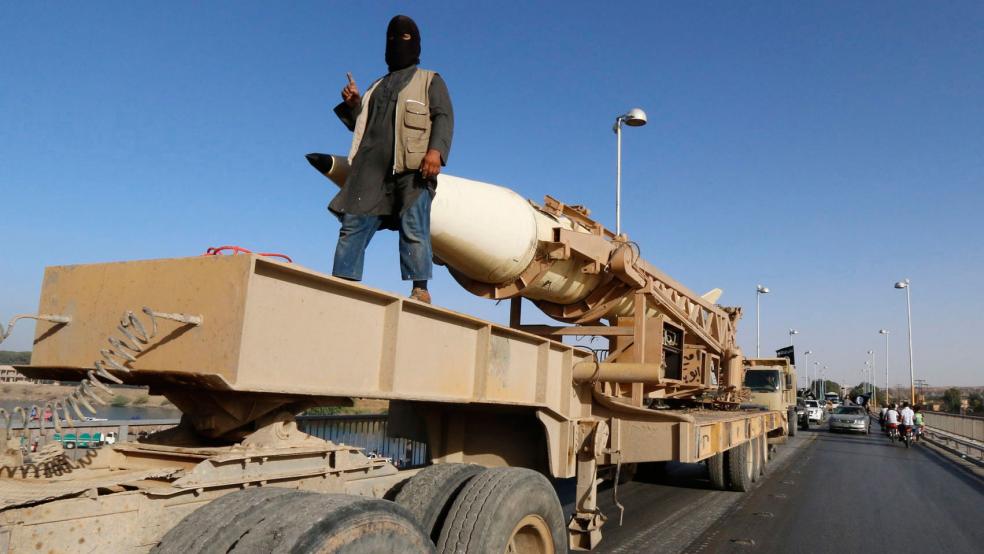The Congressional Budget Office (CBO) typically scores congressional actions, but Authorizations to Use Military Force (AUMFs) are anything but typical. When President Obama asked for an AUMF against Syria in late 2013, CBO told the Senate Foreign Relations Committee, “The administration has not detailed how it would use the authority that would be provided by this resolution; thus, CBO has no basis for estimating the costs of implementing [the AUMF].”
CBO may well take the same stance with the ISIS AUMF the president offered last week, since the proposed legislation does not outline a specific set of military actions whose costs can be estimated.
This is unfortunate, as wars can be costly and administration experts have been known to grossly underestimate the expense. In 2003, President George W. Bush fired economic adviser Lawrence Lindsey after Lindsey suggested that the Iraq War might cost as much as $200 billion – a number others in the administration thought to be greatly exaggerated but that ultimately ended up being an order of magnitude too low.
Related: Ridge Says Terror Risks Higher Than After 9/11
While Obama’s ISIS strategy may be hard to score, it may be easier to put a number next to proposals made by some of his Republican critics. Hardliners such as Sen. Lindsey Graham of South Carolina and Sen. John McCain of Arizona have criticized Obama for fully withdrawing from Iraq, preferring instead the garrisoning of a residual force on Iraqi territory. McCain has repeatedly referenced South Korea, where the U.S. maintains a military presence 60 years after the end of the Korean War. More recently, Graham has called for the deployment of “somewhere around 10,000” U.S. ground troops to combat ISIS.
Given these comments, it is reasonable to conclude that Graham and McCain would like to see 10,000 U.S. troops stationed in Iraq for the next few decades. It also would be reasonable to estimate the budgetary cost of such a deployment. Unfortunately, I doubt whether anyone will ask CBO to score this idea.
But we do have some numbers that could assist in formulating a cost estimate. A recent Congressional Research Service report cited a cost of $1 million per soldier per year for deployments in areas like Afghanistan, where opposing forces are active. Applying this cost to Senator Graham’s proposed troop level yields a cost estimate of $10 billion annually.
Related: How ISIS Could Drag the U.S. into a Ground Fight
Since Graham, McCain and other Republicans opposed the previous Iraq withdrawal and speak favorably about long-term deployments, it would be fair to assume that the U.S. would incur this incremental $10 billion cost each year for several decades. Using a traditional 10-year CBO scoring window, we would be looking at a $100 billion addition to federal deficits.
This number is most likely an underestimate for two reasons. The troop strength of 10,000 is a minimum: If ISIS proves difficult to defeat or takes American soldiers prisoner, there will undoubtedly be calls for a troop surge – as we saw both in Iraq in 2007 and Afghanistan in 2009. Second, combat veterans will require additional VA services for decades to come.
Besides those who will need treatment for physical injuries, many more will need psychiatric help for post-traumatic stress disorder. It’s obvious that the budgetary cost can never capture the pain these physical and psychological injuries will cause new veterans and our families.
Which leads to the question of whether this $100 billion-plus expenditure is worthwhile. Maybe not when one considers the limited benefits to the U.S. of a successful operation.
Related: Obama Crusades Video Bolsters ISIS Propaganda Campaign
Defeating ISIS in Iraq and Syria will not end radical Islamic terrorism: Groups will continue to have safe havens in Yemen and Libya (a failed state created by a previous U.S./European intervention). Further, terrorist attacks on the West can be planned and executed without a safe haven in the Islamic world – as shown by the recent attacks in Copenhagen, Paris, Ottawa and Sydney.
Not only won’t a ground war against ISIS prevent future terrorist attacks, it may inspire them. Perceived U.S. atrocities against Muslims at Guantanamo Bay, in Abu Ghirab and on the battlefields of Iraq and Afghanistan have provided a recruiting platform for radical Islamists. News of further victimization of Muslims at the hands of American forces during an ISIS war could be used to radicalize a new generation of prospective terrorists.
Unfortunately, when retired military officers and national security experts appear on cable news to demand stepped up action against ISIS, they rarely offer anything approaching a proper cost-benefit analysis like the one outlined here. One reason, for these commentators, is that the cost-benefit of renewed war is incontrovertible: There are lots of benefits and very few costs. More military action means more income for the national security commentariat.
Earlier, I mentioned a cost estimate of $1,000,000 per soldier per year of military action. Of course, the soldier’s salary and benefits account for a tiny fraction of the cost. Much of the rest goes to the defense contractors that provide logistical support. A number of the folks we see on Fox News and other media outlets demanding stepped up intervention are already consultants to these war profiteers.
For this reason, the media needs to do a better job of balancing pro-war voices with informed analysts who oppose intervention – such as those associated with Win Without War and Antiwar.com. The public needs to see experts from peace groups on the same platform with war proponents, so that it can make an informed decision about the next war – this time, taking all potential costs and benefits into account.
Marc Joffe is the principal consultant at Public Sector Credit Solutions and was previously a senior director at Moody’s Analytics.
Top Reads from The Fiscal Times:
- Jeb Bush on His Brother: ‘Mistakes Were Made’
- Beheadings Show ISIS Has Formed a Vast Power Center
- 9 ISIS Weapons That Will Shock You



